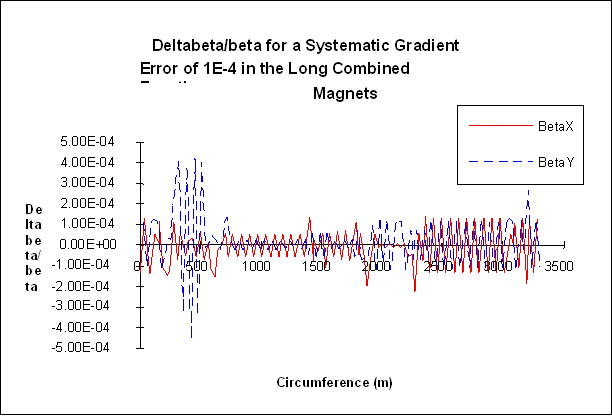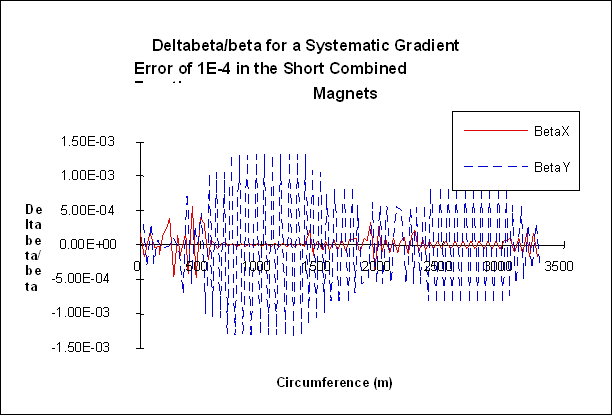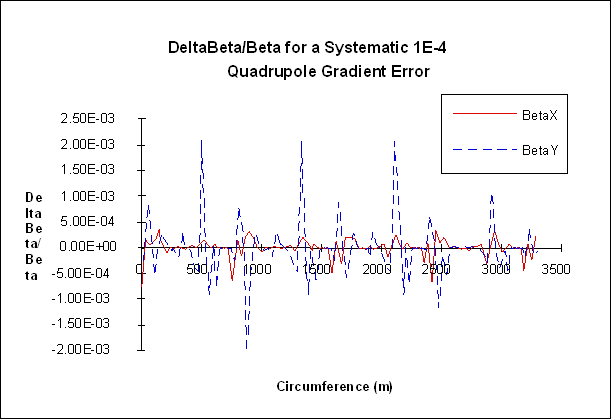
The Recycler Ring utilizes a total of 344 combined function and 88 quadrupole magnets to provide optical focusing. Since these are all permanent magnets, construction of a ring with the expected optical characteristics requires that the magnetic field gradient in these elements be close to the design value. The purpose of this note is to quantify the impact on Recycler horizontal and vertical b-functions, tune, and coupling of both systematic and random gradient errors in the combined function and quadrupole magnets. Both normal and skew gradients are considered.
Systematic gradient errors can arise either from imprecision in our understanding of the absolute value of the beam energy delivered from the Booster or Antiproton Accumulator (expected to be known to few x 10-4), or from systematic fabrication errors. The impact of a 1x10-4 systematic gradient error on the Recycler optical functions is analyzed separately for the long (4.1 m) and short (2.7 m) combined function magnets, and for the quadrupole magnets. Db/b is calculated at each horizontal (for b x) or vertical (for by) beam position monitor for a systematic integrated gradient offset of 1x10-4 relative to nominal. Recycler lattice RRV6 is used in this exercise and the perturbed b-function is calculated using the expression:

where the sum is taken over all magnets of a given type, and Dkl is taken as 1x10-4 times the nominal integrated gradient. It should be noted that in this calculation the tune of the ring is not held fixed, butis allowed to vary. Results are shown in Table 1 and in the accompanying figures. The table shows the rms b -function distortion and the accompanying tune shift. The figures show the b-function distortion as a function of position around the ring. As can be seen from the table the vertical lattice function is most sensitive to systematic gradient errors in the short combined function and quadrupole magnets. This is because the non-uniform placement of these elements does not provide the high degree of cancellation of systematic errors associated with 90o cells.
Table 1 also displays the global coupling, as measured by the minimum horizontal-vertical tune split achievable, for a systematic skew quadrupole component of magnitude 1x10-4 of the normal gradient. It should be noted that the assumption here is that the sign of the skew quadrupole component is the same in both the focusing and defocusing magnets. In this case all systematic skew fields add coherently and the coupling is quite large. If the systematic skew gradients actually alternate sign between the focusing and defocusing elements the minimum tune split is reduced by more than two orders of magnitude.
Table 1: Recycler tune shifts, rms b -function distortions, and minimum tune split arising from a systematic gradient and skew quadrupole error of 1x10-4 of nominal in the combined function and quadrupole magnets.
Dnx |
Dnx | Dbx/b>x(rms) | Dby/by(rms) | Dnmin | |
| Gradient Magnet (4.1m) | |||||
|---|---|---|---|---|---|
| integrated gradient DB'L/B'L=.0001 |
.0019 | -.0019 | 0.94x10-4 | 1.3x10-4 | |
| skew quadrupole B'sL/B'L=.0001 |
44x10-4 | ||||
| Gradient Magnet (2.7m) | |||||
| integrated gradient DB'L/B'L=.0001 |
.0012 | -.0012 | 2.3x10-4 | 8.5x10-4 | |
| skew quadrupole B'sL/B'L=.0001 |
26x10-4 | ||||
| Quadrupole magnets | |||||
| integrated strength DB'L/B'L=.0001 |
.0006 | -.0006 | 1.8x10-4 | 5.3x10-4 |
Random gradient errors can arise from either random fabrication errors, from transverse misalignment errors (in the case of the long combined function magnets containing a substantial sextupole component), or from azimuthal (roll) alignment errors. The impact of a 1x10-4 rms random gradient error on the Recycler optical functions is analyzed separately for the long (4.1 m) and short (2.7 m) combined function magnets, and for the quadrupole magnets. The rms value of Db/b is calculated using the expression:

where the sum is taken over all magnets of a given type, and skl is taken as 1x10-4 times the nominal integrated gradient, or 0.25 mm times the nominal integrated sextupole strength, as the case may be. Results are shown in Table 2. It should be noted that effects coming from an uncorrected closed orbit of several millimeters in the long combined function magnets are not included in this calculation under the assumption that they will be corrected. If left uncorrected, however, such effects can lead to beta function distortions of several percent.
Dbx/bx(rms) |
Dby/by(rms) |
Dnmin |
|
| Gradient Magnet (4.1m) | |||
| integrated gradient sB'L/B'L=.0001 | 11x10-4 |
11x10-4 |
|
| transverse displacement sd=.00025 m | 26x10-4 |
44x10-4 |
|
| roll sf=.0001 | 6.0x10-4 |
||
| Gradient Magnet (2.7m) | |||
| integrated gradient sB'L/B'L=.0001 | 9.0x10-4 |
9.0x10-4 |
|
| roll sf=.0001 | 4.9x10-4 |
||
| Quadrupole magnets | |||
| integrated strength sB'L/B'L=.0001 | 5.6X10-4 |
5.9X10-4 |
|
| roll sf=.0001 | 3.2X10-4 |
Tables 1 and 2 show the rms b -function distortion around the ring and the minimum tune split expected for the designated errors. For any set of errors the expected rms beta distortion or minimum tune split can be calculated by scaling the numbers listed in the tables and then adding in quadrature. For example, a 1x10-3 random integrated gradient error in all magnets, accompanied by a 0.25 mm random alignment error in the long combined function magnets would lead to an overall beta function distortion of 1.4x10-2 (horizontal) and 1.5x10-2 (vertical). Likewise, a random alignment (roll) error of 0.5 mr in all combined function and quadrupole magnets would be expected to produce a tune split of Dnmin=0.004.
It should be noted through a comparison of Tables 1 and 2 that, with the exception of the impact of the short combined function and the quadrupole magnets on the vertical b-function, in general systematic errors are more benign than random errors. This would lead us to expect control of the systematic gradient errors at a level comparable to the random errors should be sufficient to minimize b-function distortions.

Figure 1: The b-function distortion expected around the circumference of the Recycler from a systematic integrated gradient error of 1x10-4 in all long combined function magnets.

Figure 2: The b-function distortion expected around the circumference of the Recycler from a systematic integrated gradient error of 1x10-4 in all short combined function magnets.

Figure 3: The b-function distortion expected around the circumference of the Recycler from a systematic integrated gradient error of 1x10-4 in all quadrupole magnets.